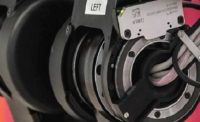If humanoid robots could talk, they would readily admit that their real-world capabilities are much more limited than those showcased in movies and TV shows. The reason is because they are based on technology developed in the 1970s and 1980s to automate factories.
This technology requires robots to always be as stiff as possible for extended wear life and reliability. In contrast, Hol-lywood robots are always compliant and move as if possessing elastic muscles and tendons.
Not all compliant robots are the stuff of fiction however. Several engineers at the Robot Studio (based in Divonne-Les-Bains, France) have created two compliant robot torsos over the past decade or so.
Several years of research led to the development of Cronos in 2007. This robot enables engineers to investigate the relationship between visual perception (seeing things), sensor motor skills (doing things) and the sensation of experience (machine consciousness). Its head moves in all directions and features a single pan-tilt-roll camera for an eye. The robot also has a flexible spine complete with vertebral discs, two arms that can each lift 2 kilograms, and the first working, powered copy of the human shoulder with gliding shoulder blade.
In 2012, the Studio unveiled ECCERobot, which stands for Embodied Cognition in a Compliantly Engineered Robot. ECCERobot is said to be the first anthropomimetic robot; that is, a robot that truly mimics the inner structures and mechanisms of a human being.
The robot’s bones are made of polymorph, and its tendons of kiteline. Muscles are actuated by screwdriver motors, and muscle elasticity is provided by shock cord. Like Cronos,
ECCERobot’s shoulders are capable of multiple degrees of freedom, and its hands can grip objects of various sizes.
The engineers also decided to accurately measure stress on the robot’s hands, arms and shoulders while lifting objects. They placed more than 60 LSB200 load force sensors at locations along each forearm and below each shoulder. SENSIT test and measurement software records and analyzes the data. Both products are from FUTEK Advanced Sensor Technology Inc.
The LSB200 was chosen because of its miniature size (0.75 inch wide and 0.25 inch thick) and its 1,000 percent safe overload rating, which enables the sensor to withstand incidental loads up to 10 times its calibrated range. This sensor measures both tensile and compression forces ranging from 1 microgram to 100 pounds.
Nonrobotic applications include process control, medical testing, pharmaceutical research and aerospace safety analysis. The sensor is available with either a 4-40 or a M3 x 0.5 thread and features either anodized 2024-T4 aluminum or 17-4H stainless steel construction.
Impressed with the LSB200’s accuracy, Studio engineers plan to install many sensors in its upcoming biomimetic human torso that mimics biochemical processes in humans.
For more information on load force sensors, call 949-465-0900 or visit www.futek.com.



